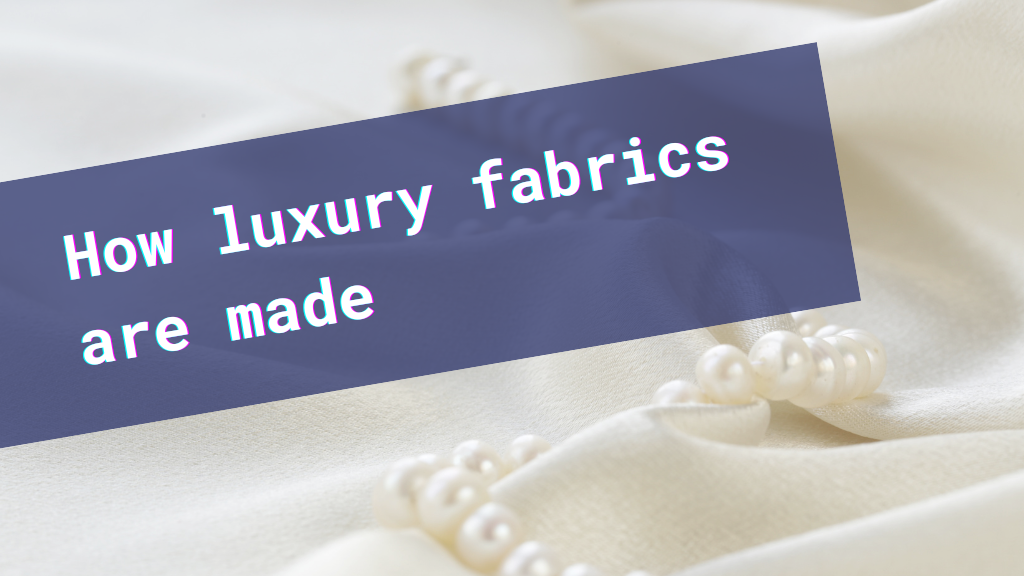If you’re the type of writer or world-builder who likes to lose yourself in the details, today’s post is for you.
In this companion guide to my list of 30+ luxury fabrics, I get into the nitty-gritty on how luxury fabrics and textiles are made.
In this post, you’ll learn:
- the difference between a fabric and a textile
- the process used to create cloth
- types of fibers used throughout history, including extremely rare ones!
- the difference between filament and staple fibers
- weaves used to create luxurious fabrics
I’ll also include some historical and cultural facts, as well as links to additional resources so you can dive even deeper, if inspired!
This post was originally part of a comprehensive but way-too-long article on luxury fabrics. For convenience and readability, the content was moved here and expanded.
Table of Contents
What’s the difference between a fabric and a textile?
The terms fabric and textile are often used interchangeably in the world of fashion, but fabrics are actually a type of textile.
Textiles encompass a wide variety of products made from natural or synthetic fibers, including the felts and yarns used to make fabrics. Textiles also have many industrial, medical, technical, and commercial uses.
Fabrics, on the other hand, are woven, knitted, or felted textiles typically used to create clothing and accessories.
How luxury fabrics and textiles are made
Fabrics are made by weaving, knitting, or felting fibers together to create a workable cloth. When most people think of fabric, however, they probably think of woven fabric.
Some of the steps involved in making luxury fabric include:
- harvesting the fibers
- cleaning and sorting the fibers
- spinning the fibers into yarns
- dyeing or treating the yarn
- weaving the yarn into fabric
- finishing/treating the fabric
- folding or wrapping the fabric in bolts
From start to finish, the process can be quite labor-intensive! And these steps don’t even include turning the luxury fabric into a piece of clothing, which requires its own set of skills.
Also, fabric companies can follow different approaches when it comes to sourcing yarns.
For example, large fabric conglomerates may have vertically integrated operations where they produce their own yarns and control the supply chain from start to finish. Smaller companies might rely on yarns from external suppliers.
The decision depends on various factors, including the company’s size, specialization, production capabilities, and business model.
There are also many techniques for weaving yarns into fabric, and some techniques are less common than others.
For example, in some parts of the world, techniques are passed down from one generation to the next as part of a local or family tradition.
Because these techniques can be quite labor-intensive and only performed in certain areas of the world, they result in exclusive yarns and fabrics that fetch a high price in the luxury market.
Fibers used to create luxury fabrics and textiles
Yarns can be made from natural or synthetic fibers, but the most expensive yarns are natural and handmade in limited quantities.
Natural fibers come from a wide variety of sources, from plants to mammals, insects, and even sea creatures!
Natural fibers used to create luxury fabrics include:
Animal fibers



- Angora – a soft, downy fiber that comes from the molted fur of the Angora rabbit. Angora is usually blended with wool yarn to make luxurious knitted scarves, hats, and sweaters that are both warm and soft. If a sweater has a fluffy “halo” and you feel tempted to pet it, it may well have angora fibers.
- Cashmere – a soft, downy fiber that comes from the winter undercoat of cashmere goats native to the Himalayas. There are a few different breeds of goats that can produce cashmere.
- Mohair – a soft, downy fiber that comes from the hair of Angora goats. Prized for its luster and sheen, as well as its insulating properties, mohair is not to be confused with angora, which comes from the Angora rabbit.
While angora and other types of animal fiber usually can be obtained in a humane way, widespread demand for these fibers has led to the mistreatment of animals in some parts of the world.
Plant fibers


- Cotton – a soft, fluffy white fiber harvested from cotton bolls. Cotton has a long history of cultivation due to being both breathable and durable. Before the invention of the cotton gin, quality cotton fabric was too expensive for many people to wear. Also, not all cotton is the same. Different varieties have been cultivated around the world. Two of the most expensive ones today are extra-long staple Egyptian cotton and Pima cotton (more on staples below).
- Flax (linseed) – the plant fiber used to create linen. Linen is stronger than cotton and was widely cultivated throughout antiquity. The best linen was reserved for expensive lace and damask (more on damask below).
Silk fibers


- Sea silk – an extremely rare fiber harvested from pen shells. The fiber (known as “byssus”) is what the clam uses to attach itself to the seabed. Sea silk is finer than mulberry silk and incredibly lightweight yet also strong. Harvesting and trade of sea silk are restricted. You will probably never come across sea silk in real life because it’s that rare.
- Silk – the fine, lustrous fiber that comes from silkworm cocoons. Most silk comes from domesticated mulberry silkworms that are reared for this purpose. To distinguish this kind of silk from other varieties (such as wild silk), you’ll sometimes see it referred to as “mulberry silk.” Mulberry silk tends to be of better quality because the fiber is harvested before the developed silkworm moth has broken through the cocoon. (Usually, this is facilitated by boiling the creature alive inside said cocoon.) In contrast, wild silk is harvested from different kinds of non-domesticated silkworms that have already emerged from, and thus damaged, the silk fiber.
Because silk has a long, rich history and is deeply woven into the cultural fabric of many societies, it has a deeply-rooted association with luxury and nobility. These associations continue to enhance the desirability of silk today.
Why is silk so luxurious?

Silk is a strong, natural filament fiber with an attractive luster; it produces a fabric that is not only durable and versatile but also smooth, soft, and hypoallergenic.
At the same time, genuine silk is costly and labor-intensive to make, which means that not everyone can afford to wear it.
Silk can be harvested from various creatures that produce filament fibers, including mulberry silkworms (most common), spiders, and pen shells.
Can silk really be made from spider silk?
Yes, but it’s quite rare! Spider silk is known for its exceptional strength and elasticity, making it an attractive material for various applications, including textiles.
However, spiders are difficult to farm and collect silk from, which limits the availability and practicality of using spider silk as a fabric.
Filament fiber vs. staple fiber
Another way in which fibers differ is whether they’re a filament fiber or a staple fiber. These two terms will come up again, so it’s worth explaining the differences:
- Filament fibers (silk, sea silk) come in long, continuous strands, which results in a very fine, smooth yarn.
- Staple fibers (linen, cotton, and wool) come in discrete strands clumped together, which results in a hairy, insulating yarn.
Synthetic fibers such as acrylic and nylon are also filament fibers; these materials are typically cut down into staple lengths prior to being spun into yarn.
For a staple fiber, the staple length (e.g. short, long, extra-long) determines various qualities of the resulting yarn, such as its smoothness and durability. The longer the staple, the better quality the yarn. Long and extra-long staples (e.g. Egyptian cotton) are used to create luxury fabrics that are both soft and durable.
The way these fibers are spun into yarn can also affect the finished product. For example, a rough-spun yarn will have a bumpier or more pronounced texture than a smooth-spun one.
Warp yarns, weft yarns, and weaves
Weaves are the techniques used to create fabric from warp and weft yarns.
Knowing about these different techniques can help provide context as to why some luxury fabrics are named a certain way or possess certain qualities.
- Warp yarns are vertical yarns that run parallel to the selvage edges of the fabric. They are typically stronger and more tightly tensioned than weft yarns. The warp yarns are attached to the loom’s frame and are held under tension during weaving. These yarns are responsible for providing the fabric’s lengthwise stability and strength.
- Weft yarns, also known as filling or woof yarns, are horizontal yarns that interlace with the warp yarns during weaving. They are woven back and forth across the width of the fabric, passing over and under the warp yarns. Weft yarns are usually less tensioned than warp yarns and are inserted using a shuttle or other weaving tools. They give the fabric its width and contribute to its overall structure and appearance.
The interlacement of the warp and weft yarns creates the characteristic pattern and structure of the woven fabric.
The specific weaving pattern and density of the warp and weft yarns determine the fabric’s texture, weight, and other properties.
Examples of weaves used to create luxury fabrics
Some of the weaves used to make luxury fabrics include:
Plain weave
Don’t be misled by the word “plain!”
Plain weave is a strong weave used to create muslin, organdy, organza, linen, silk, chiffon, voile, crepe, and other luxurious fabrics.
Plain weave is also a preferred weave for embellishing, as it provides a smooth, flat surface that is ideal for embroidery.
Other names for it are linen weave, taffeta weave, and tabby weave.

Basket weave
Basket weave is a simple, strong weave characterized by a crisscross pattern. It’s similar to plain weave but involves the equal interlacing of two or more warp threads with two or more weft threads.
Basket weave fabric has a distinctive checkerboard-like appearance and provides good durability and breathability.
Oxford fabric is created with this weave.

Rib weave
Rib weave is similar to plain weave but either the warp or weft yarn is thicker, resulting in a ribbed appearance. Yarns may also be woven two at a time to enhance the ribbing effect.
This weave is used to create fabrics such as faille, Charvet, poplin, and grosgrain, which are used in fine suits, skirts, and coats.
Rib weave is one of the base weaves (along with plain and satin) from which many other weaves are derived.

Twill weave
With twill weave, the warp or weft yarns go under or over the other two at a time, creating a diagonal pattern in the fabric.
It’s not uncommon for the warp and weft yarns to be of different colors or made from different fibers.
Twill weave is used to create fabrics such as denim, flannel, velvet, and gabardine, among others.

Herringbone weave
Herringbone weave is a type of broken twill weave that results in a zig-zag pattern with yarns in 2 or 3 different colors.
Herringbone weave can be used to make tweed fabric. Tweed is fashioned into suits, hats, and outdoor apparel.
The name “herringbone” comes from the V-shape, which resembles a fish bone. Other names for herringbone weave are feather twill and arrow twill.

Satin weave
Satin weave is a luxurious weave in which silk weft yarns are floated over a continuous warp yarn, resulting in a fabric that is slippery and shiny on one side and matte on the other.
Because of these floating yarns, however, satin is also more prone to snags.
Satin weave is used to create fabrics such as charmeuse and Duchesse. Actually, any fabric that uses the satin weave can be called satin, but traditional satin (the most luxurious satin) is made using genuine silk.

Sateen weave
Sateen weave is similar to satin weave but the warp yarn is floated over a continuous weft yarn, and the yarn used is typically a short-staple yarn such as cotton.
As a result, sateen is less slippery and shiny, and the difference between the front and back sides may not be as stark as with satin.
Because it creates a smooth fabric resistant to wrinkling, sateen weave is a popular weave for making bed linens.

Pile weave
Pile weave is used to create velvet, terrycloth, corduroy (ribbed velvet), and velveteen. These fabrics have a raised or textured surface that feels plush and velvety-soft.
Pile weave fabrics can be cut (as with velvet) or uncut/loop (as with terrycloth).
When making velvet, the technique involves weaving two layers at a time. The loops holding these two layers together are cut, which allows them to be peeled away into two separate pieces of velvet fabric.
Leno weave
Leno weave is a unique style of weaving where special warp yarns (called doup yarns) are twisted around weft yarns to create an airy mesh or netting.
Also known as a cross weave and gauze weave, it is thought to have been invented in ancient Egypt.
Tulle is a popular example of a leno weave fabric, though leno techniques can also be applied to other sheer fabrics such as voile and organza.
Jacquard weave
Jacquard weave is a complex, highly decorative weave performed on a Jacquard loom.

Jacquard weaving patterns are used to create a variety of expensive brocade, damask, brocatelle, and matelassé fabrics.
The designs created using a Jacquard loom can be ornate and unique, and Jacquard patterns can make use of many different types of yarns, further expanding the realm of what’s possible when it comes to Jacquard fabric.
Because both the weave and the fiber define a finished fabric, you’ll sometimes see labels such as “silk satin” and “cotton sateen.” This is to make it clear that the satin is made from silk, for example, and not some other fiber.
In fact, there are also different finishes that can change the color, texture, and durability of fibers, by making the resulting fabric stiffer or more resistant to wear and tear.
The phrase “in the lap of luxury” is an expression that refers to living a life of extreme comfort, opulence, and extravagance. Its origins can be traced back to the 18th century, where the term “lap” referred to the space between the knees when sitting.
“In the lap of luxury” suggests reclining comfortably in a luxurious setting, surrounded by wealth and indulgence. It is a figurative expression that conveys a state of great affluence and lavish living.
If this topic interests you, you may find this glossary of textile manufacturing helpful.
Whether you’re a writer, roleplayer, or world-builder, I hope you found this post useful and informative! If you enjoyed it, don’t forget to check out my post on luxury furs and leathers next.






Leave a Comment